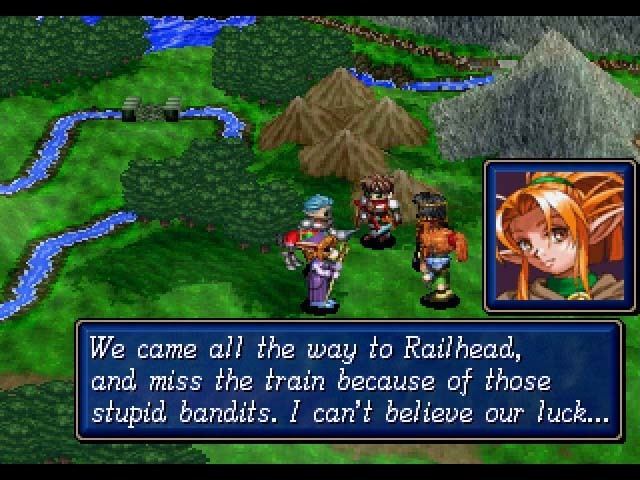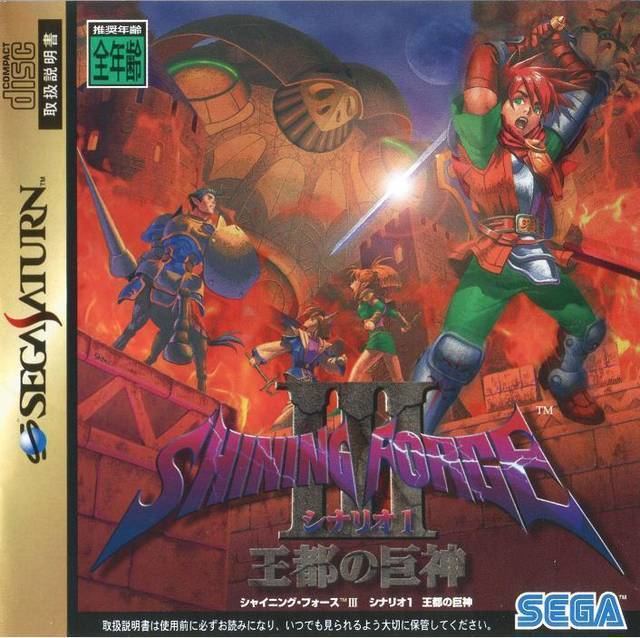9.6 /10 1 Votes
5/5 eBay Initial release date 11 December 1997 | 4.6/5 Emuparadise Director(s) Yasuhiro Taguchi Writer(s) Hiroyuki Takahashi Mode(s) Single player Series Shining Designer Hiroyuki Takahashi | |||||||||||||||||||||||||||||||||
 | ||||||||||||||||||||||||||||||||||
Similar Shining games, Camelot Software Planning games, Tactical role-playing games | ||||||||||||||||||||||||||||||||||
Cgr undertow shining force iii review for sega saturn
Shining Force III (シャイニング・フォースIII, Shainingu Fōsu III) is a fantasy turn-based tactics role-playing video game designed for the Sega Saturn by Camelot Software Planning. It is a continuation of the Shining series. Comprising three separate but overlapping storylines, the Japanese version of Shining Force III was released in three volumes, known as: Scenario 1 | "God Warrior of the Kingdom" Scenario 2 | "Target: Child of God", and Scenario 3 | "Bulzome Rising". For players who collected all three volumes, Camelot Soft also issued a Premium Disc featuring artwork, a character model viewer, and additional extras.
Contents
- Cgr undertow shining force iii review for sega saturn
- Shining force iii review for the sega saturn
- Gameplay
- Characters
- Scenario Three
- Plot
- Trial version
- References

In the United States and Europe, only Scenario 1 was released. The real ending to the game can only be viewed by completing all the games in the series.

Shining force iii review for the sega saturn
Gameplay

Like earlier Force games in the Shining series, Shining Force III is a turn-based tactical role-playing game. Battles take place in square grids, and each unit occupies one square. Each unit can move up to a fixed amount of squares along the battlefield, determined by its Move statistic. Depending on its location relative to enemies and to allies, a unit can also perform one action: attack, cast a spell, use an item, or search the area. Some commands, such as equipping or dropping items, do not count as actions. The order of turns is determined by the unit's agility score and a random seed.

As is typical for an RPG, units become stronger by fighting enemies or by performing other actions in battle, such as healing allies. These actions give the units experience points (EXP), which allow them to gain levels.

Each character has a class, which defines a set of abilities for that unit and determines the spells and equipment they have access to. A character can be promoted to another class at any level between 10 or 20. Upon promotion the character's level resets to 1 and statistics are reduced by a fixed amount, although they begin higher if the character had been promoted at a higher level.
Battle goals for the player are fairly simple: kill all enemies, kill the enemies' leader, or advance to a town or landmark. The enemy side wins if they kill the player's leader (Synbios in Scenario 1, Prince Medion in Scenario 2 and Julian in Scenario 3), or if the player chooses to escape the battle by casting Return. Even if the player army is defeated, the player can recover allies and retry the battle. The Force keeps any experience that is obtained, regardless of the battle's outcome. Thus, there is no Game Over, and the player's army gets stronger even upon its defeat, although the leader's death results in the player losing half of their money.
Shining Force III also possesses an exploration mode that occurs outside of battle. This gameplay mode is essentially a Japanese-style traditional RPG, along the lines of Final Fantasy or Dragon Quest, although there are no labyrinths and few puzzles to solve. In this mode, the player's army is represented by its leader, who is able to walk around, interact with people, find treasure, buy equipment and items, outfit the army and choose which of the army's members will be used in battle.
Characters
Each Scenario has its own roster of playable characters, representing different races and classes. Each Force starts out small, but throughout the game more characters can be recruited, building the Forces up to considerable size.
Scenario Three
Synbios' and Medion's Forces become playable again once player reaches Remotest. All three Forces can be used to progress to final battle.
Plot
Scenario 1, God Warrior of the Kingdom, features Synbios, a young lord from the Republic of Aspinia. Aspinia was once a part of the Empire of Destonia, but seceded after a war of independence spearheaded by some of the more democratic-minded nobles. They opposed Emperor Domaric's totalitarian policies, which disenfranchised a large number of people, creating a huge disparity between the wealthy and the poor. Tensions remained between Aspinia and Destonia after the secession, marked by occasional border disputes.
As the game begins, Synbios is part of a military force representing Aspinia at a peace conference in the neutral city of Saraband. Due to manipulation by outside forces - later discovered to be connected with a religious cult known as the "Bulzome Sect" - full-scale war breaks out again between Aspinia and Destonia. The majority of the game's storyline covers this conflict as well as Synbios and his team's fight against the Bulzome sect. Throughout the game Synbios has periodic encounters with Medion, Destonia's youngest prince, who also recognizes the truth behind the war. Although on opposite sides of the war, the two work together to identify the real threat. Medion's role is portrayed in more detail in Scenario 2.
Scenario 2, Target: Child of God, features Medion, Prince of Destonia, and youngest of three sons of Emperor Domaric. Although loyal to his father and his country, he senses that there are other forces at work beneath the tensions between Aspinia and Destonia. He attends the conference in Saraband on behalf of Destonia, along with his brothers Arrawnt and Mageron. As discovered in Scenario 1, much of this influence comes from the Bulzome sect, as well as collaborating separatist factions within both Destonia and Aspinia. Medion works parallel to Synbios of Aspinia, often disposing of rogue Aspinian elements to spare Synbios's force from fighting against its own countrymen. At the end of the game, Medion is forced to battle with Synbios' force when Julian steps in to stop them.
Scenario 3, Bulzome Rising, stars Julian, a mercenary who appears as a secondary character in both Scenario 1 and Scenario 2. He is for all intents and purposes the true main character of Shining Force III. His initial motivation as the story begins is to track down and kill Galm, one of, if not the, most powerful member of the Vandals, a powerful race of beings that existed over 1,000 years ago. Julian believes that Galm killed his father and is seeking revenge. This story arc is first introduced in an earlier Shining game, Shining the Holy Ark, in which Julian appears as a young boy who asks the party to search for his missing father.
Julian joins Synbios in the midst of his quest in Scenario 1, but after an encounter with Galm, he is tossed over a waterfall at the suspension bridge and believed by Synbios' army to be dead. He reappears in Scenario 2, apparently washing ashore at the site of a battle between Medion's army and the Bulzome Sect. Knowing the sect's ties to the Vandals, Julian agrees to fight alongside Medion. As it becomes clear that the sect is trying to kill Gracia, a child intended to become the next Innovator (A Shining Series figure equatable to a god), Julian takes on the task of protecting him and helping him realize his destiny.
Scenario 3 starts about 60% through scenario 2's story, and focuses primarily on battles against the Bulzome Sect and their allies in both Aspinia and Destonia. While scenarios 1 & 2 happen at roughly the same time, much of scenario 3 takes place after both, but there is some "overlap". Eventually Julian leads a three-party coalition consisting of the armies of both Synbios and Medion, to engage in the final conflict against Bulzome, a powerful Vandal long sealed in another dimension, and the true orchestrator of the conflict.
Trial version
In 1997, Sega produced a trial version of the game featuring several key differences, such as an unused level format, different voices for certain characters, and monsters that were removed from the retail version of the game. This demo was only available in Japan, and thus is a sought after item for retro gaming collectors and RPG collectors alike. With its key differences (such as a final level that is not featured in the final game) the Beta version was Sega's way of testing the market for one of its popular series. The differences from the finished game are very noticeable, such as:
